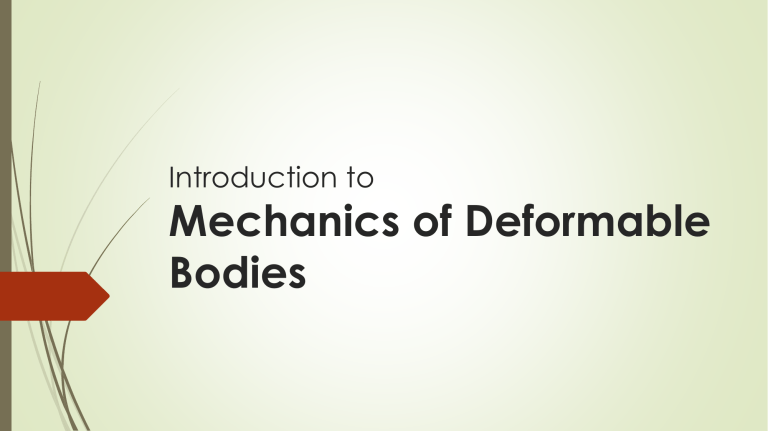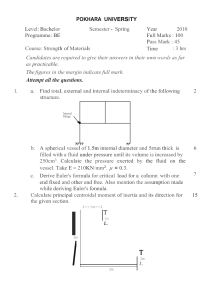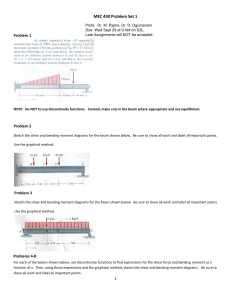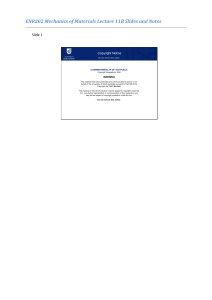
Introduction to Mechanics of Deformable Bodies What is Mechanics of Deformable Bodies? Also known as Mechanics of materials/ Strength of materials Deals with the relations between externally applied loads and their internal effect on bodies. Moreover, the bodies are no longer assumed to be ideally rigid; the deformations, however small, are of major interest. The properties of the material of which a structure or machine is made affect both its choice and dimensions that will satisfy the requirements of strength and rigidity. Analysis of Internal Forces Axial Force. This component measures the pulling (or pushing) action over the section. A pull represents a tensile force that elongates the member, whereas a push is a compressive force that shortens it. Shear Force. These are the components of the total resistance to sliding the portion to one side of the exploratory section past the other. Torque. This component measures the resistance to twisting the member. Bending moments. These components measures the resistance to bending the member about the Y and Z axes. Analysis of Internal Forces y Bending Moment (My , Mz) z Shear Force (Py , Pz) Torque (Mx) x Axial Force (Px) Simple Stress When a force is transmitted through a body, the body tends to change its shape or deform. The body is said to be strained. Applied Force (F) Simple Stress =Cross Sectional Area (A) Units: Usually N/m2 (Pa), N/mm2, MN/m2, GN/m2 or N/cm2 Note: 1 N/mm2 = 1 MN/m2 = 1 Mpa Simple stress may be tensile or compressive and result from forces acting perpendicular to the plane of the cross-section Shearing Stress Shearing Stress is the stress due to the shearing force applied to the resisting area. Applied Force (F) Stress =Cross Sectional Area (A) Where: A= (π/4)(d)2 Torsion Is a shear stress that acts on a transverse cross-section which is caused by the action of a twist. Torsional shear stress can be thought of as the shear stress produced on a shaft due to twisting. Tc Torsion = J T= torque c= distance of farthest fiber J= polar moment of inertia For Solid Shaft 16T ST = π 𝐷2 For Hollow Shaft 16TD ST = π (𝐷4 −𝑑4) Bearing Stress Stress caused by a force which is perpendicular to the resisting area. It is the contact pressure between two separate bodies. Applied Force (F) Stress =Cross Sectional Area (A) Bending/ Flexural Stress Bending stress is the normal stress that an object encounters when it is subjected to a large load at a particular point that causes the object to bend and become fatigued. Rectangular Section Circular Section Mc 6M Sf = I = bh3 Mc 32M Sf = I = π𝐷3 M = bending moment I = moment of Inertia C = distance from farthest fiber Thermal Stress Thermal stress is the stress produced by any change in the temperature of the material. Thermal stress is induced in a body when the temperature of the body is raised or lowered and the body is not allowed to expand or contract freely. Thermal stress includes both heat and cold stress. Eδ St = L St = E (ΔT) E = modulus of elasticity Δ = Elongation = coefficient of thermal expansion






